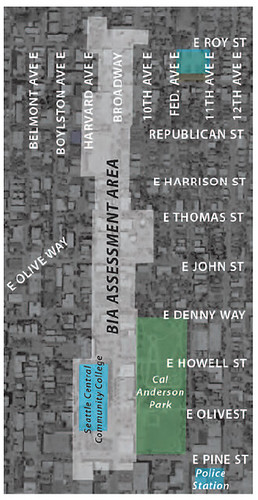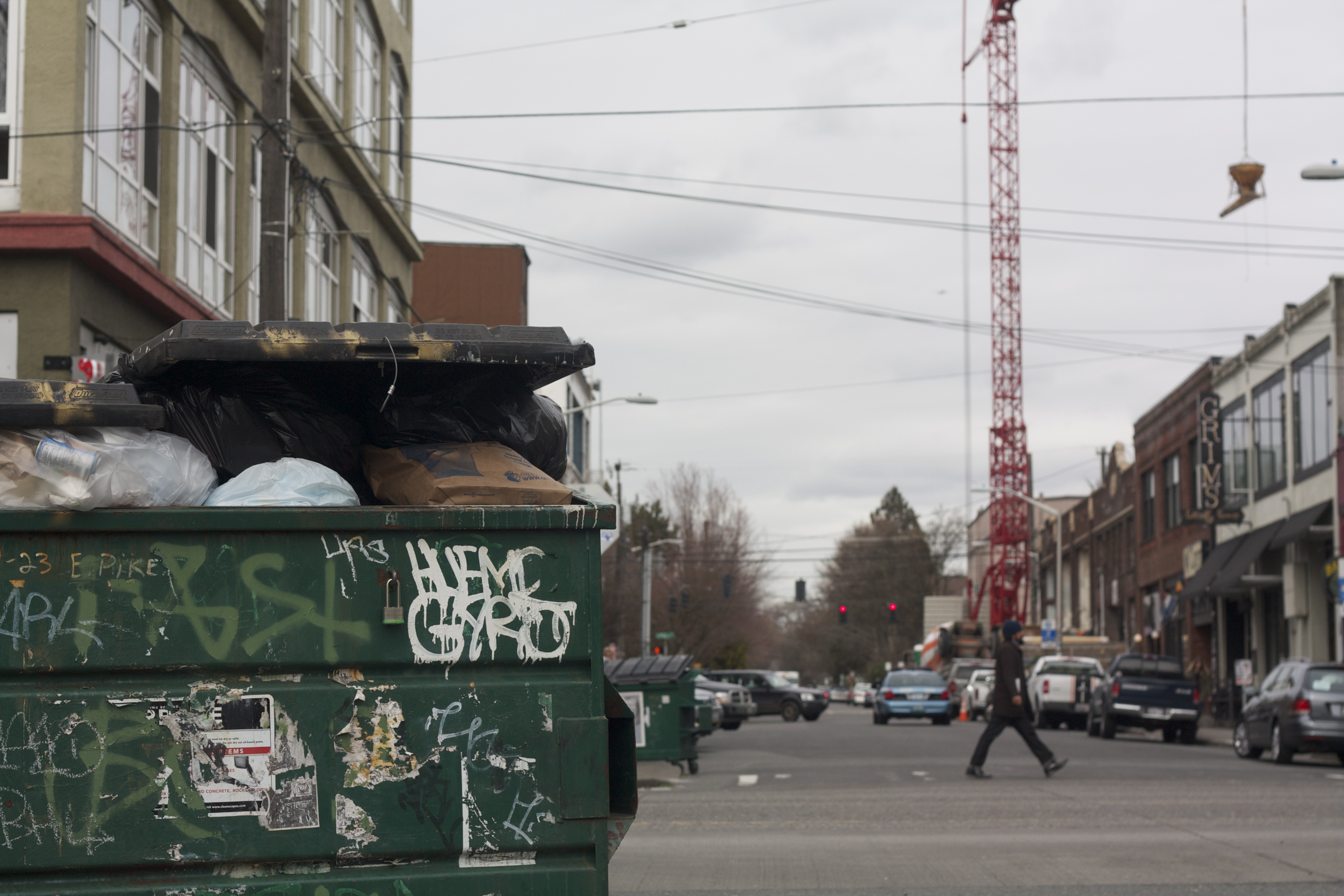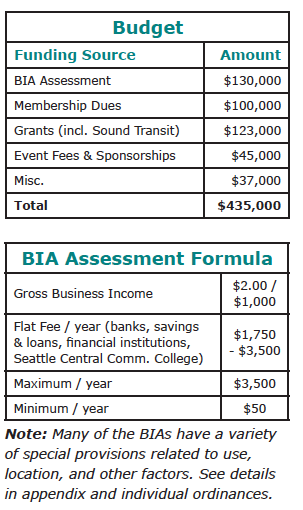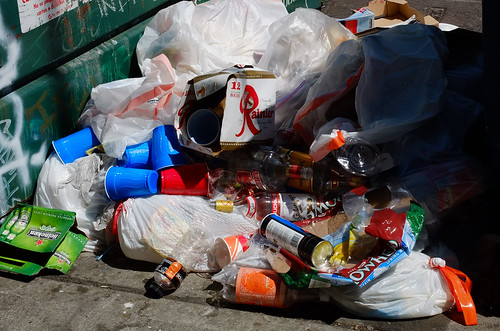
 A good day at 11th and Pike (Image: CHS)
A good day at 11th and Pike (Image: CHS)
We won’t try to quantify it. We won’t even try to say things have gotten worse. Perhaps, per capita, it’s as messy and filthy as ever. But, a victim of its own success, Pike/Pine is grubby and gritty. Broadway — bastion of cleanliness — could be one model for cleaning it up.
“It comes up because Pike/Pine merchants will ask, why don’t we get our streets cleaned? But there’s more to it than that,” says Michael Wells, executive director of the Capitol Hill Chamber of Commerce.
The Capitol Hill chamber is described as the “administrative agent” for the entity known as the Broadway Business Improvement Area. Created in 1986, the organization is one of seven such districts in Seattle. Here’s how the areas work:
A BIA provides an annual budget to fund services and improvements in neighborhood business districts by assessing property and/or business owners who benefit from the improvements. BIA funds can be used for services such as parking, joint marketing, cleanup and maintenance, security, special events, beautification, and professional management. The City contracts with each BIA, and each BIA is governed by a ratepayer’s advisory board. The City collects the assessments and reimburses BIA expenses.
For the Broadway BIA, that adds up to a more than $400,000 budget for everything from litter and graffiti removal along Broadway, to banners to hanging flower baskets and holiday decorations.
“I know that for Capitol Hill there’s been a shift or maybe broadening in economic activity to the Pike/Pine area, a shift not envisioned when the BIA first started,” Seattle City Council president Sally Clark writes. “Back then you still had Broadway Market as a beehive, Bailey/Coy and others making that northern stretch of Broadway feel like the hub. (It felt like a hub back when I worked the Bulldog News stand in the Market.)”
“Now you have this intense stretch of activity up and down Pike/Pine,” Clark said. “Major Capitol Hill economic activity has stretched out, but the boundaries of the ‘special attention’ area haven’t changed. “
The money to suport a BIA comes from a mixed recipe — each of the city’s zones have a different combination of funding. On the Hill, membership fees and an assessment based on gross income — $2 for every $1,000 generated — provide the bulk of the program’s budget. The smallest of businesses in the assessment zone pay in the area of $100 year plus the membership fees. Larger players are capped at a maximum of $3,500 per year — though we’re told that hasn’t been a ceiling often reached.
Dave Meinert, already a member of a downtown improvement area, says he would support expansion to “help Pike/ Pine keep streets cleaner” and so the neighborhood “would also benefit from other services provided.” Money from the Capitol Hill Block Party festival he helped to create could also help power a BIA. CHS reported on Block Party’s expanding community involvement here.
Jill Cronauer of developer and property manager Hunters Capital — which has several holdings that could potentially fall within an expanded BIA zone — says an expanded program would better help distribute “the financial responsibility” of keeping up the neighborhood:
BIA’s have several benefits and from a landlord’s perspective, the general maintenance services and graffiti removal provided by CleanScapes is the greatest. This is a service we pay for out of pocket nearly every day already. Not every landlord does this so at times we end up picking up the trash from our neighbors. This is a huge expense! With a BIA, the financial responsibility is spread around. Everyone pays, everyone benefits, and the streets, sidewalks and storefronts are more enjoyable for everyone.
A BIA’s presence also extends beyond trash and graffiti. The organizations have become conduits for solving neighborhood issues and opportunities with city programs. SPD and other departments check in with the boards and program leaders for buy-in, sign-off and community representation. In short, at a civic level, the groups have clout.
Despite the enthusiasm for growth, to expand the Broadway BIA to Pike/Pine and create a larger Capitol Hill assessment zone is a significant undertaking. Under the current agreement, the Broadway BIA is limited to changes in its assessment rates and borders that come in under a 10% increase in assessment revenue. That would be a slow route to spreading the program south. But it could be less painful than forging a more significant overhaul.
60% of all potential members in the existing and newly proposed area would need vote to approve any agreement to create the new borders under the city’s Office of Economic Development program. Then the agreement must be approved by the City Council. How the new zone is established and what powerful players are in and out can make or break the effort.
A mid-2000s push to create a Capitol Hill Improvement District with an expanded mandate died a slow, quiet death marked by infighting over how the program should be shaped. It has taken seven years but the Hill’s business community might finally be ready to broach a similar topic again.
“That’s the question for the property owners and their tenants south of the existing boundary,” Council president Clark said. “Is it time to expand the boundaries? More activity is great, but it can also mean more mess on a Saturday morning, more graffiti to paint out.”
Meanwhile, the Broadway business community’s stomach for changing the program may also have to make room for a levy program to help pay for the extension of the streetcar to near Volunteer Park. Pike/Pine could also go it alone and form its own BIA. Perhaps 15th Ave will also want a piece of the action. And the membership fee and grant-driven Chamber itself must wrestle with its role in the shadow of a possible assessment-funded, combined Broadway-Pike/Pine business group.
The soul searching going on around the Broadway BIA and a potential expansion isn’t unique to Capitol Hill. People familiar with the program and city officials say similar issues are coming up in the six other improvement areas around the city. The OED has brought in a contractor to work with the BIAs and examine how they are performing and how many of them might expand. Will Capitol Hill lead the way?
“What’s the most active business district on the Hill?” the Chamber’s Wells asks. No need to answer the rhetorical. “What’s the best model to make it happen?” That last one the businesses and organizations of Broadway and Pike/Pine will need to sort out.






Great story, Justin,on very complex issues. Just one point; the Boadway BIA brings in approximately $140,000 a year, not $400,000. 70% of that income goes to street cleaning and graffitti maintenance. The rest goes to beautification efforts – flower baskets and banners and the like.
Our respective organizations will be having this conversation this year along with the Pike/Pine community and deciding how and if we would like to proceed.
Pike-Pine is somewhat of a disaster area as far as a reasonable level of cleanliness. Part of the problem is the overflowing trash cans and dumpsters, and many of these are stored permanently on the public right-of-way so they are very visible. It would help if all businesses in that area used the “dumpster-free” program offered by CleanScapes for their garbage and recycle, but it would have to be a mandatory requirement because many businesses would otherwise opt out and continue their current, messy ways.
Another factor is the rampant postering in the area and subsequent ignoring of the postering regulations. Many of the utility poles, and other structures, have old posters to a thickness of 1-2″…..and these are often tattered and moldy, giving the street a very unkempt appearance. I would like to see the poster ban revived, but unfortunately this is not likely because of the powerful influence of the “nightlife lobby.”
Thanks — I’ll double back with you for clarification on the $435,000 budget tallied by the city (included in the table embedded in the post)
Former efforts to establish a comprehensive Business Improvement District failed due to apathy or outright opposition by property owners who either didn’t care or insisted that ‘doing their own thing’ was enough, not “infighting”.
Those of us who were proponents of an expanded improvement area hoped that eventually, new energy and investment would arrive with the turnover of Pike Pine’s significant properties. That’s certainly happening fast, maybe we’re finally ready to step up and pay the relatively modest maintenance costs that will make such a positive impact.
Thanks for covering this important topic Justin.
Thanks.
Lastly, please confirm those BIA budget numbers with Michael Wells, they are actually much lower.
Thanks.
Thanks. I’ve added an update above attempting to explain the total reported by the city compared to the regular operating budget the BBIA works with.
I dunno if I like the idea of a poster ban. I think it gives the neighborhood character.
The Pike/Pine business community has a different relationship to postering that the Broadway BIA, due partially to the many music venues in the Pike/Pine corridor. Any discussions around cleanliness around postering and such would live w/ the ratepayers of the area if an improvement district were to be implemented.
Anything to clean up the hideous dumpsters and they’re overflow that spreads out all over Pike/Pine/10th/11th every day
Has anyone ever proposed the idea of poster kiosks, like they use in more beautiful cities like Paris? In Paris, current events are posted tastefully and old posters are removed once the events have closed. It would greatly enhance the P/P corridor. Venues could still advetise for free and the streets would not be littered with obsolete flyers (aka garbage).
Sure that sounds fine and all, but remember this is Cap Hill: people enjoy the trash and graffiti because it adds “character”. Whatever that is.
This is all well and good. I’m sure that a long range comprehensive solution to the problem will take time and coordination (and money.) But, in the mean time, why does not every single property owner feel at least some inclination to lift a finger? I’m sure that those who do make an effort to keep the sidewalks and streets in front of their businesses are frustrated by the total lack of effort by others. I live near this nightlife nirvana and I accept as part of the deal I’ll have to pick up the litter and garbage in my block from time to time. And the posters on poles and walls are not what I’m talking about. As a good example, take a walk on 10th Avenue between Union and Pike. This block, like others, has long gone beyond the stage of pleasing urban grittiness. While we are waiting for the long-term solution, can’t a few property owners who are or will be reaping the benefit of having a stake in this vital neighborhood exercise some responsibility? Just a thought.
That area is definitely a mess. If the business owners in that area are ok with it, I think a BIA would be a good solution to the trash problem that has grown with the popularity of those blocks as a nightlife district. If Mr. Groberman is so against being part of a BIA, then just move the boundary – they do a good job on that block, I say let them keep doing it if they want.
Re poster ban – I remember right when the poster ban was lifted. It was a renaissance of poster art all over the neighborhood. It was amazing. Posters still keep me up to date on what’s going on in the neighborhood, and they act as street art (some more than others, true). Let’s not get rid of them!
I hope you are right that the time may be right for another effort to get a BIA established. Kudos to Mr. Groberman for taking such good care of his property, but he is the exception in Pike-Pine. Most business owners there make little or no effort to clean up the area in front of their business. It is rare to see an employee out front sweeping and picking up litter. In most cases, “doing their own thing” really means “doing nothing.”
Your suggestion sounds nice in theory, but it would not work in Seattle (and especially on Capitol Hill) because those who poster have the mind-set that they can put them up wherever and whenever they wish, and that the City’s postering regulations are just there to be ignored.
Postering in Paris is highly regulated and people respect the rules because they actually care about the appearance of their streetscape. Not so here.
Who wants Pike and Pine to look like Broadway?
Broadway is no longer Broadway . . . it could be “anywhere” USA.
A street in Akron, or maybe Indianapolis. The street no longer reflects
anything of what Capitol Hill was(is?). Its not urbanization, its more like suburban sprawl.
I’d take a little grubbiness in the Pike/Pine corridor rather than have turn out anything close to what Broadway has become.
Another Subway? maybe a Wendy’s or a Macdonalds . . .time to move.
For starters, make Pike and Pine One way streets. Besides trash it’s a total chaos, people, cars, bicycles, buses, trucks, turns, crossings, no traffic lights at intersections. There is no space to do anything safe, because of so many crossings. Very disorganized and set up for accidents. I guess the most important part is there is no place to pull over to load or unload passengers or to park a car without stopping everything. Bicyclists slow down buses big time too. Bicycles on bus lanes must be the most insane idea in urban planning. Never seen it in any big cities, except Seattle.
[…] CHS has learned that CleanScapes, the company contracted by the Broadway improvement district for tidying up the area, has been asked to clean the poles every day in an attempt to keep the streetcar markers unmarked – another reason to expand the improvement district? […]
[…] around Capitol Hill — with a focus in Pike/Pine. The grant could also help open the door to expanding the Hill’s business improvement district – currently limited to […]